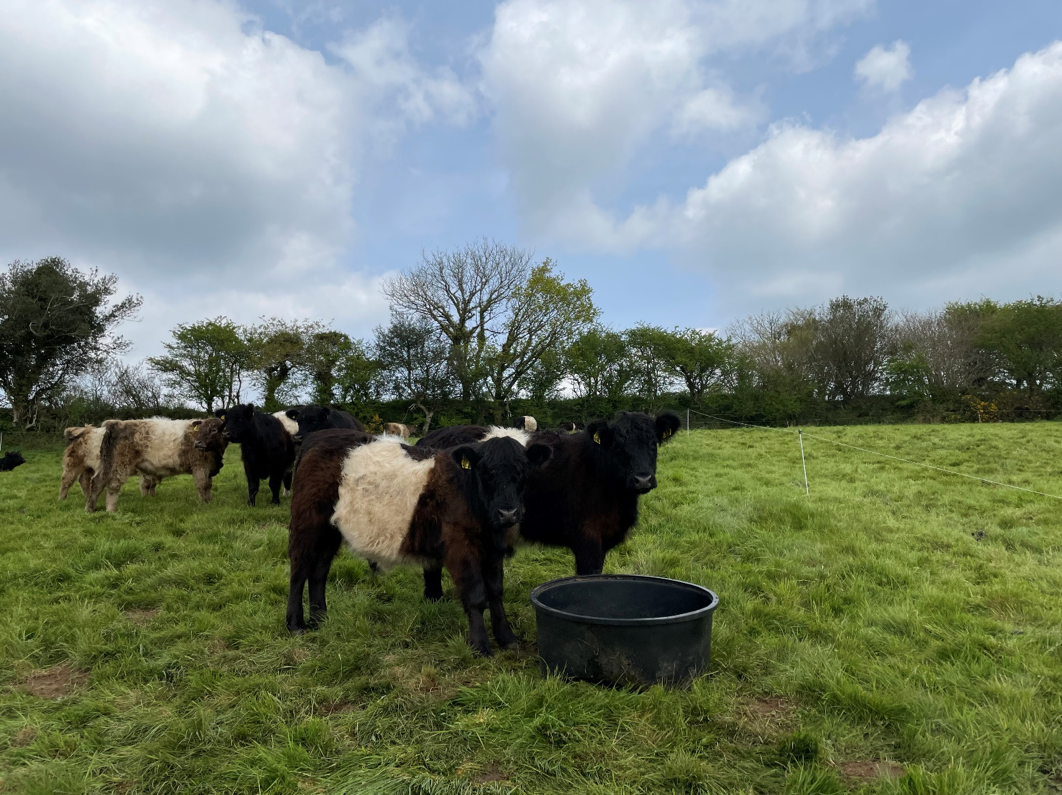
A Farm Net Zero event held at Ben Thomas’s monitor farm in Warleggan.
With fertiliser and feed rising in cost, many farmers are looking at how to grow grass and livestock with fewer inputs. A group of farmers gathered at one of the Farm Net Zero (FNZ) Monitor Farms to learn about rotational/mob-grazing from farmer Ben Thomas, and grazing consultant James Daniel of Precision Grazing Ltd. Ben Thomas farms 100 acres of species-rich permanent pasture in Warleggan, with 20 Belted Galloway finishing cattle moved daily in ⅓-acre plots. Winter stocking rate limits livestock numbers but Ben aims to reach 60-80 cattle. The landowner’s main aims are biodiversity, carbon sequestration and sustainable food production, and the rotational grazing system Ben employs allows for this, as well as fitting around Ben’s off-farm work as a farm manager.
James Daniel provided an introduction to rotational grazing, including how to get started. James proposed that the main limiting factor to grassland productivity is infrastructure (fencing and water) and suggested that if farmers are planning to cut their fertiliser use, they would see the benefit of using some of their fertiliser budget on investing in infrastructure. James explained that the main principle of rotational grazing is not to graze recent re-growth; the roots on overgrazed plants will die off, reducing the speed of recovery and making pasture more susceptible to drought. Grazing should be at a speed that maintains vegetative growth, leaving leaf on the plants to maximise photosynthesis and subsequent re-growth.
Key takeaways:
- Invest in infrastructure and start by splitting larger fields.
- “Wasted” grass can protect soil, regrow faster and potentially extend the grazing season
- Focusing on production from grass can reduce emissions from fuel, fertiliser and bought-in feed and improve soil carbon sequestration
Adopting rotational grazing can grow high-quality feed with fewer bought-in inputs. Fertiliser (and fuel to spread it) is a major contributor to a farm’s carbon footprint. If enough grass can be produced with less of these inputs then the farm will be closer to achieving Net Zero, as well as saving money. James referenced an Agri-Tech Cornwall funded study at Rothamsted Research North Wyke that found that rotational grazing increased the rate of soil organic matter (SOM) accumulation. If this is translated into soil carbon, then rotational grazing can help to capture carbon to offset the farm’s emissions. The same study also suggested that rotationally grazed plots had a lower weed burden, higher rates of available phosphorus and potassium and produced a higher liveweight gain per hectare than set-stocking. This suggests that rotational grazing can improve profitability by increasing production per unit of land and by keeping the soil and pasture in good condition.
Useful resources:
More information on Precision Grazing Ltd can be found here: https://precisiongrazing.com/
Preliminary results from the Agri-Tech Cornwall funded Cell Grazing research at Rothamsted Research North Wyke are available in a webinar here: https://www.youtube.com/watch?v=Hvu5Oj6ieYU
What next?
Ben’s fields will be soil sampled and his farming operation carbon footprinted until the Farm Net Zero project ends in 2025. This monitoring will provide valuable information on the impact of rotational grazing both on soil carbon and the overall carbon footprint of the farm.
This event was made possible with thanks to the National Lottery Community Fund who fund the Farm Net Zero project.

